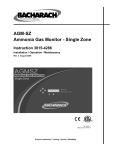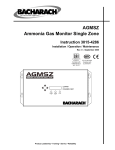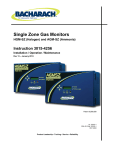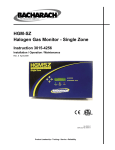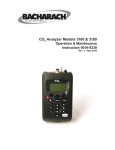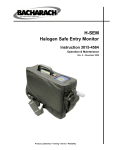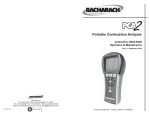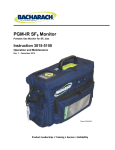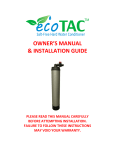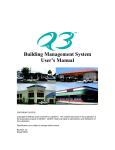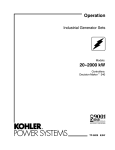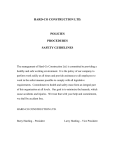Download Bacharach HGM-SZ Specifications
Transcript
HGMSZ Halogen Gas Monitor Single Zone Instruction 3015-4256 Installation / Operation / Maintenance Rev. 3 – June 2006 Complies with UL 61010A-1 and CSA 22.2 No. 1010.1 Product Leadership • Training • Service • Reliability WARRANTY Bacharach, Inc. warrants to Buyer that at the time of delivery this Product will be free from defects in material and manufacture and will conform substantially to Bacharach Inc.'s applicable specifications. Bacharach's liability and Buyer's remedy under this warranty are limited to the repair or replacement, at Bacharach's option, of this Product or parts thereof returned to Seller at the factory of manufacture and shown to Bacharach Inc.'s reasonable satisfaction to have been defective; provided that written notice of the defect shall have been given by Buyer to Bacharach Inc. within two (2) years after the date of delivery of this Product by Bacharach, Inc. Bacharach, Inc. warrants to Buyer that it will convey good title to this Product. Bacharach's liability and Buyer's remedy under this warranty of title are limited to the removal of any title defects or, at the election of Bacharach, to the replacement of this Product or parts thereof that are defective in title. The warranty set forth in paragraph 1 does not apply to parts the Operating Instructions designate as having a limited shelflife or as being expended in normal use (e.g., filters). THE FOREGOING WARRANTIES ARE EXCLUSIVE AND ARE GIVEN AND ACCEPTED IN LIEU OF (I) ANY AND ALL OTHER WARRANTIES, EXPRESS OR IMPLIED, INCLUDING WITHOUT LIMITATION THE IMPLIED WARRANTIES OF MERCHANTABILITY AND FITNESS FOR A PARTICULAR PURPOSE: AND (II) ANY OBLIGATION, LIABILITY, RIGHT, CLAIM OR REMEDY IN CONTRACT OR TORT, WHETHER OR NOT ARISING FROM BACHARACH'S NEGLIGENCE, ACTUAL OR IMPLIED. The remedies of the Buyer shall be limited to those provided herein to the exclusion of any and all other remedies including, without limitation incidental or consequential damages. No agreement varying or extending the foregoing warranties, remedies or this limitation will be binding upon Bacharach, Inc. unless in writing, signed by a duly authorized officer of Bacharach. Register Your Warranty by Visiting www.bacharach-inc.com Declaration of Conformity Manufacturer’s name: Bacharach, Inc. Manufacturer’s address: 621 Hunt Valley Circle New Kensington, PA 15068 European Operations: Bacharach Europe Ltd. Sovereign House, Queensway Leamington Spa Warwickshire CV31 3JR United Kingdom Product Name: HGMSZ (Halogen Gas Monitor Single Zone) conforms to the following harmonized European EMC standards: EN61326-1 EN61000 EN55022 Notice: Product improvements and enhancements are continuous; therefore the specifications and information contained in this document may change without notice. Bacharach, Inc. shall not be liable for errors contained herein or for incidental or consequential damages in connection with the furnishing, performance, or use of this material. No part of this document may be photocopied, reproduced, or translated to another language without the prior written consent of Bacharach, Inc. Copyright © 2003 – 2006, Bacharach, Inc., all rights reserved. ® BACHARACH is a registered trademark of Bacharach, Inc. All other trademarks, trade names, service marks and logos referenced herein belong to their respective owners. A Instruction 3015-4286 Table of Contents INTRODUCTION........................................................................................................................................... 1 How to Use This Manual ......................................................................................................................... 1 Warning Statements................................................................................................................................ 1 Caution Statements ................................................................................................................................. 1 Hazard Symbols on Monitor.................................................................................................................... 1 Safety Precautions ................................................................................................................................... 2 AC Power Supply.................................................................................................................................. 2 Protective Grounding ........................................................................................................................... 2 Explosive Atmosphere.......................................................................................................................... 2 Proper Exhaust Venting ...................................................................................................................... 2 Working Inside Monitor ....................................................................................................................... 2 Misuse and Modifications to Monitor.................................................................................................. 2 In Case of Malfunction ......................................................................................................................... 2 Fusing.................................................................................................................................................... 2 Installation Category ........................................................................................................................... 2 Altitude Limit ....................................................................................................................................... 2 Cleaning ................................................................................................................................................ 2 Functional Overview................................................................................................................................ 3 General Description ............................................................................................................................. 3 Understanding Monitoring Levels ...................................................................................................... 3 Response to the Presence of Multiple Refrigerants ........................................................................... 3 Suggested Location of Sampling Point ............................................................................................... 4 INSTALLATION............................................................................................................................................ 5 Installation Considerations ..................................................................................................................... 5 Warnings and Cautions ....................................................................................................................... 5 Inspection.............................................................................................................................................. 5 Locating the Monitor............................................................................................................................ 5 Mounting Instructions ............................................................................................................................. 6 Connecting Gas Sample and Exhaust Lines .......................................................................................... 6 Overview ............................................................................................................................................... 6 Tubing Considerations ......................................................................................................................... 7 Connecting the Gas-Sample Line ........................................................................................................ 7 Connecting the Exhaust Line .............................................................................................................. 7 Interior Schematic ................................................................................................................................... 8 Electrical Wiring ...................................................................................................................................... 9 Connecting External Alarms................................................................................................................. 10 Overview ............................................................................................................................................. 10 Connection .......................................................................................................................................... 10 4–20 mA Current Loop Interface .......................................................................................................... 11 OPERATION............................................................................................................................................... 13 Front Panel Display and Controls ........................................................................................................ 13 General Operation ................................................................................................................................. 13 Display Screens ...................................................................................................................................... 14 Initial Power Up ................................................................................................................................. 14 Data Display Screen........................................................................................................................... 14 Function Screens ................................................................................................................................ 15 Working with Gas Alarms ..................................................................................................................... 18 Overview ............................................................................................................................................. 18 Clearing / Silencing a Gas Alarm ...................................................................................................... 18 Viewing the Gas Alarm Log............................................................................................................... 18 Instruction 3015-4256 i Working with System Faults ................................................................................................................ 18 Overview ............................................................................................................................................. 18 Clearing / Silencing a Fault Alarm ................................................................................................... 18 Viewing the Fault Log ....................................................................................................................... 19 Fault Codes......................................................................................................................................... 19 Clearing the Stored PPM Log, Alarms & Faults Data........................................................................ 20 Entering Custom Refrigerant Calibration Values............................................................................... 20 Reset to Factory Default Settings......................................................................................................... 20 Working with the DIAGNOS Function ................................................................................................ 21 Overview ............................................................................................................................................. 21 Keypad Functions .............................................................................................................................. 21 First Diagnostic Screen ..................................................................................................................... 21 Second Diagnostic Screen .................................................................................................................. 21 Working with the P-CHK Function...................................................................................................... 22 Overview ............................................................................................................................................. 22 Keypad Functions .............................................................................................................................. 22 Screen Display.................................................................................................................................... 22 Working with the Calibration Function............................................................................................... 23 Overview ............................................................................................................................................. 23 Calibration Procedure........................................................................................................................ 23 Adjusting Calibration Factor ............................................................................................................ 23 MAINTENANCE ......................................................................................................................................... 25 Warnings and Cautions......................................................................................................................... 25 Charcoal Filter....................................................................................................................................... 25 Hydrophobic Filter................................................................................................................................. 25 Servicing Air Lines & Termination Filters .......................................................................................... 25 Fuses....................................................................................................................................................... 25 Clock Battery ......................................................................................................................................... 25 Sample Pump ......................................................................................................................................... 25 Replacement Parts & Optional Accessories ......................................................................................... 26 Replacement Parts ............................................................................................................................. 26 Optional Accessories .......................................................................................................................... 26 Service Centers ...................................................................................................................................... 27 Specifications ......................................................................................................................................... 28 APPENDIX.................................................................................................................................................. 29 Table of Recommended Alarm Settings ............................................................................................... 29 ii Instruction 3015-4256 Introduction How to Use This Manual Thank you for investing in a Bacharach HGMSZ (Halogen Gas Monitor Single Zone) monitoring unit. To assure operator safety and the proper use of the HGMSZ monitor, please read, understand, and follow the contents of this manual, which provides important information on the installation, operation, and maintenance of the monitor. If you have a working knowledge of refrigerant monitors, you will find this manual useful as a reference tool. If you are new to the use of refrigerant monitors, you can educate yourself about the principles of refrigerant gas detection and the proper operation of this device by reading this manual thoroughly. Warning Statements The use of the word WARNING in this manual denotes a potential hazard associated with the use of this equipment. It calls attention to a procedure, practice, or condition, or the like, which if not correctly performed or adhered to, could result in personal injury or death. Caution Statements The use of the word CAUTION in this manual denotes a potential hazard associated with the use of this equipment. It calls attention to a procedure, practice, condition, or the like, which if not correctly performed or adhered to, could result in damage to the equipment. Hazard Symbols on Monitor This symbol indicates the need to consult this operating instruction manual when opening the enclosure. WARNING: A potential risk exists if the operating instructions are not followed. This symbol indicates the presence of electric shock hazards when the enclosure is opened. WARNING: To avoid risk of injury from electric shock, do not open the enclosure without first disconnecting AC power. Instruction 3015-4256 1 Safety Precautions AC Power Supply The HGMSZ uses a universal power supply that is capable of accepting inputs of 100 to 240 VAC, 50/60 Hz. The monitor’s power consumption is 15 Watts. It is highly suggested that the monitor be connected directly to the AC power source, preferably on its own circuit (with UPS or surge protection). A switch or circuit breaker rated 1.0 A, 250 VAC, with a minimum terminal spacing of 3.0 mm must be attached to the monitor’s AC power leads. This switch must also be located in close proximity to the monitor, and be in easy reach of the operator. This switch should also be clearly marked as the monitor’s main AC disconnect device. Protective Grounding Under no circumstances should the HGMSZ be operated without connection to a protective ground. Doing so poses a potential shock hazard and is also a violation of electrical safety standards applicable to this type of equipment. Explosive Atmosphere Do not operate this equipment in the presence of flammable liquids, vapors or aerosols. Operation of any electrical equipment in such an environment constitutes a safety hazard. Proper Exhaust Venting It is imperative that the monitor’s exhaust port be vented as described in this manual. Failure to do so may constitute a safety hazard. Working Inside Monitor Extreme care should be exercised when accessing the interior of the monitor. Only qualified electrical maintenance personnel should perform connections and adjustments. Always remove AC power before working inside the monitor. Misuse and Modifications to Monitor The protection provided by the monitor may be impaired if the monitor is used in a manner not specified by Bacharach, Inc. Changes or modifications to this monitor, not expressly approved, will void the warranty. In Case of Malfunction Do not continue to use this equipment if there are any symptoms of malfunction or failure. In the case of such occurrence, de-energize the power supply and contact a qualified repair technician or the nearest Bacharach Service Center. Use ONLY the provided knockouts for electrical and communication wiring. Drilling into the box will void the warranty. Fusing F1, F2: 1.0 A, 250 V, Type “F” Installation Category Installation Category II, Pollution Degree II, as defined by UL. Altitude Limit 6,562 ft (2,000 m) Cleaning To clean the outside of the case, DO NOT use soap and water. USE a dry cloth. 2 Instruction 3015-4256 Functional Overview General Description Refrigerant monitors are specified to support compliance to federal, state and local safety codes governing refrigerant emissions. Avoiding significant refrigerant loss reduces equipment replacement costs, maintains equipment efficiency, promotes safety, and protects the environment. The Bacharach HGMSZ (Halogen Gas Monitor Single Zone) monitoring unit is easily programmed to continuously monitor the level of any one of several types of refrigerant gases in an area that is located up to 50 ft (15.2 m) away from the monitor. The HGMSZ displays the type of gas being monitored, along with displaying both the current gas level and the peak gas level detected in that area on its front panel LCD. The monitor retains a log of previous readings that can be easily accessed for analysis. An audible alarm and front panel indicators are provided to signal alarm and fault conditions, and relay contacts are provided that can be used to trigger external alarm devices in the event of a system fault, or if a leak (small), spill (medium), or evacuation (large) level of gas is detected. The system also includes a 4−20 mA current loop interface that can be connected to remote monitoring equipment. The HGMSZ requires only minor periodic maintenance such as the occasional replacement of filters. The monitor incorporates active diagnostics that continuously check the system for proper operation. A front panel indicator is provided to alert an operator of system malfunctions, and fault codes are generated that enable the operator to identify the cause of the fault. Understanding Monitoring Levels Effective use of this monitor requires an understanding of what constitutes reasonable alarm set points for the type of gas being monitored. All AC&R systems leak some refrigerant. In a good “tight” installation these background levels will be acceptably low and often do not require corrective action. You can reduce nuisance alarms and needless service calls if the alarm levels are set at practical limits. Refrigerant manufacturers define allowable exposure levels and threshold limit values in units of parts per million (ppm). Bacharach has developed recommended monitoring levels based on compliance to ANSI/BSR ASHRAE 15-1994 and ASHRAE Safety Code 34-1992. These reference levels are listed in the Appendix (Page 29). Setting the monitor at these recommended alarm levels will satisfy the needs of most users. However, the ppm levels generated by system leaks into the environment are greatly influenced by the volume of air in the sampling area, air circulation, size of the leak, distance to the monitoring point, and a host of other variables. In some cases the set points may need to be adjusted either up or down to achieve effective monitoring. Response to the Presence of Multiple Refrigerants The HGMSZ is a refrigerant level monitor, not a gas analyzer. You must program the monitor to test for a specific refrigerant, and it will only return accurate concentration readings for that particular refrigerant. If a leak occurs of another refrigerant gas type, the monitor may return incorrect readings. Most applications only require detection of a single refrigerant and the problems that are associated with monitoring multiple gases are rarely an issue. If there is a possibility of multiple refrigerants leaking in the same sampling zone, then you should carefully consider which refrigerant compound you program the unit to monitor. Instruction 3015-4256 3 Suggested Location of Sampling Point At the point of a refrigerant leak the gas is nearly pure. As the refrigerant is dispersed into the air, the gas molecules diffuse causing a dilution of the original concentration. The HGMSZ measures the refrigerant concentration at the point the sample is collected. Therefore, if the termination of the collection line is not at the exact point of the refrigerant leak, then the monitor will read a diluted mixture of the refrigerant gas and air. It should also be noted that halogen refrigerant gas is heavier than air and tends to collect below the point of a leak. Therefore a sample taken near the floor will have a greater concentration of gas than that collected above the source of a leak. Consequently, the sampling point should ideally be located as close as possible to the source of a potential leak. If this is impractical, then the alarm set points should be adjusted to compensate for the dilution of the refrigerant gas. The HGMSZ should be mounted outside of the mechanical room or at least just inside of a door to the room. The monitor should be readily accessible for easy visual monitoring and servicing. The gas-sample line can be up to 50 ft (15.2 m) in length. If the area around the monitor is not well ventilated, then an optional exhaust line can be run to an outside location. The length of the exhaust line cannot exceed 50 ft (15.2 m). It may be necessary to perform a “smoke” test of the mechanical room to determine the best monitoring point. The smoke test would provide the pattern of air currents present in the room. HGMSZ Refrigerant Gas Leak Monitor Mechanical Room Placement 4 Instruction 3015-4256 Installation Installation Considerations Warnings and Cautions WARNING: Explosion hazard! Do not mount the HGMSZ in an area that may contain flammable liquids, vapors or aerosols. Operation of any electrical equipment in such an environment constitutes a safety hazard. WARNING: Shock hazard! Always disconnect AC power before working inside the monitor. CAUTION: Drilling holes in the HGMSZ enclosure may damage the unit and will void the warranty. Please use knockouts provided for electrical connections. CAUTION: The HGMSZ contains sensitive electronic components that can be easily damaged. Be careful not to touch or disturb any of these components. Inspection The HGMSZ has been thoroughly inspected and tested prior to shipment from the factory. Nevertheless, it is recommended that the monitor be re-checked prior to installation. Inspect the outside of the enclosure to make sure there are no obvious signs of shipping damage. Open the enclosure and inspect the interior of the monitor for loose components that may have become dislodged during shipment. If damage is discovered, please contact the nearest Bacharach Service Center for assistance. Locating the Monitor Locate the HGMSZ so that no more than 50 ft (15.2 m) of tubing will be needed to reach the sampling area, and that no more than 50 ft (15.2 m) of tubing will be required for the exhaust. Since the monitor uses ambient air to zero its gas sensor, the monitor should be located in an area that normally does not contain refrigerant gas. If an exhaust line is not used, then locate the monitor in a well ventilated area so that the exhaust gas does not accumulate around the monitor’s ventilation holes. The HGMSZ should be operated in an environment that is between 32 and 122°F (0 and 50°C), has a relative humidity of between 5 and 90% non-condensing, and is at an altitude of no more than 6,562 ft (2,000 m). The area should also be relatively free of dirt, grease, and oils that could adversely affect the operation of the monitor. The location should allow the monitor to be easily accessible for visual monitoring and servicing. Instruction 3015-4256 5 Mounting Instructions The HGMSZ should be installed plumb and level and securely fastened to a rigid mounting surface. The enclosure utilizes keyhole mounting brackets designed for #12 pan head screws. Locate the four screws as shown in the diagram below and leave the screw heads protruding approximately 3/16". Enclosure Mounting Specs Hold the monitor flat against the mounting surface and allow it to slide down engaging the screw heads in the keyhole slots of the mounting brackets. Adjust the screws as necessary to hold the monitor securely against the mounting surface. Connecting Gas Sample and Exhaust Lines Overview A single gas-sample line needs to be run from the HGMSZ to the area of the facility to be monitored. An optional exhaust line can also be installed to vent refrigerant gas away from the monitor. All tubing connections are made on the bottom of the enclosure as shown in the illustration below. HGMSZ Bottom View ½" / ¾" SERVICE KNOCKOUT* ½" / ¾" SERVICE KNOCKOUT* GAS SAMPLE INLET PORT GAS SAMPLE EXHAUST PORT * There is an additional Service Knockout on top of the case 6 Instruction 3015-4256 Tubing Considerations Use ¼" outside diameter (0.040" wall) flex tubing for all air lines (P/N 304-2743 or equivalent). The tubing should be clean and free of moisture or other contaminants. The tubing should be cut cleanly with a sharp knife and care should be taken not to distort the tubing end. Connecting the Gas-Sample Line To connect the gas-sample line to the monitor, simply push the tubing into the Gas Sample Port. All tubing bends should have a radius of no less than 5" to insure proper airflow. If kinks or obstructions occur in the line the monitor may not function properly. Please refer to Section Suggested Location of Sampling Point (Page 4) to learn more about where to take a sample. The gas-sample line can be up to 50 ft (15.2 m) in length. The end of this line should be placed near the potential leak source and positioned to reduce the possibility of mists, aerosols, oil, water, dust, or other contaminates being drawn into the monitor. For added protection, a termination filter (P/N 3015-3420) should be attached to the end of this line. CAUTION: The introduction of contaminants through the gas-sample line can result in serious and permanent damage to the monitor. Connecting the Exhaust Line The exhaust line functions to carry the exhausted gas sample away from the monitor, and is required if the monitor is located in a confined, poorly ventilated area. Note that if the monitor is exposed to an usually high level of refrigerant gas for prolonged periods of time, its charcoal filter will quickly become saturated and no longer to able to clean the purge-air of refrigerant gas. The exhaust line can be up to 50 ft (15.2 m) in length. Ideally this line should terminate outdoors in a location that is not exposed to the elements. Connect the exhaust line to the monitor by firmly pushing the tubing onto the Exhaust Port’s barbed fitting. If the exhaust line terminates outside the building, position the tubing so that no water or moisture can enter the line. Note that this line does not require a termination filter. Termination Filter (P/N 3015-3420) Instruction 3015-4256 7 Interior Schematic Interior Schematic LINE FUSES 1.0A, 250V, F HYDROPHOBIC FILTER UNIVERSAL POWER SUPPLY CONTROL BOARD SAMPLE PUMP CLOCK BATTERY AC INPUT TERMINALS AC INPUT GROUND STUD IR BENCH GAS IN 8 CHARCOAL FILTER (Used to remove refrigerant gas from the purge air) EXTERNAL ALARM RELAY CONNECTOR 4–20 MA (Signal Out. Do not apply power!) FACTORY DEFAULT SWITCH IR BENCH GAS OUT Instruction 3015-4256 Electrical Wiring The HGMSZ uses a universal power supply that is capable of accepting inputs of 100 to 240 VAC, 50/60 Hz. The monitor’s power consumption is 15 Watts. It is highly recommended that the monitor be connected directly to the AC power source, preferably on its own circuit. The AC power connection should be completed with UL approved 3-conductor wire (14−18 AWG), rated 300 VAC at 105°C. Locate a convenient service knockout and install electrical conduit in the typical manner. Locate the AC Input Terminals and Ground Stud on the inside of the monitor (Page 8). Secure the incoming AC power neutral (white) and live (black) wires to the LINE 1 and LINE 2 terminals. Using the supplied crimp-on ring terminals, washers, and nuts, connect the incoming AC power ground wire (green) to the monitor’s AC Input Ground Stud, and then install a separate wire between the ground stud and the GND terminal. A switch or circuit breaker rated 1.0 A, 250 VAC, with a minimum terminal spacing of 3.0 mm must be attached to the monitor’s AC power leads. This switch must also be located in close proximity to the monitor, and be in easy reach of the operator. This switch should also be clearly marked as the monitor’s main AC disconnect device. AC Power Connections WARNING: Electrical installation should be performed by a certified electrician, and should comply with all applicable NEC/CEC and local electrical safety codes. WARNING: The AC power ground wire must first be connected to the monitor’s ground stud. Under no circumstances should this monitor be operated without a protective ground. Doing so poses a potential shock hazard, and is also a violation of electrical safety standards applicable to this type of equipment. CAUTION: Drilling holes in the HGMSZ enclosure may damage the unit and will void the warranty. Please use knockouts provided for electrical connections. Instruction 3015-4256 9 Connecting External Alarms Overview The HGMSZ includes four SPDT relays whose contacts are rated 3 A at 240 VAC. These relays are used for the connection of external alarm devices that are activated when the relay is energized. The relays are factory assigned to energize under the following conditions: Relay #1 Relay #2 Relay #3 Relay #4 Leak Spill Evacuate Fault Alarm Point 100 ppm Alarm Point 300 ppm Alarm Point 500 ppm System Fault Event Note that the alarm points of relays #1, #2, and #3 are set using the monitor’s LEAKLVL, SPILLLVL, and EVACLVL function screens (Page 16). Connection Use any of the service knockouts to gain cable access to the interior of the monitor. Locate the External Alarm Relay Connector (Page 8). Secure the leads from the external alarm device and its power source to the connector as shown in the diagram below. The diagram on Page 11 shows a typical connection to Relay 1. Note how power to the alarm device is being tapped off the monitor’s AC Input Terminals. External Alarm Relay Connector Each relay may be connected as normally open (NO), or normally closed (NC). The relay contacts are rated 3 A at 250 VAC. Power for the external alarm devices may be supplied from an external power source, or from the monitor’s AC input terminals. 10 Instruction 3015-4256 Typical External Alarm Relay 1 Wiring Jumper the ‘Neutral’ line of an external power source or the monitor’s AC input to the ‘Common’ terminals on the relay connector. Connect one end of the strobe or horn to the ‘NO’ terminal of whichever level of alarm is appropriate for the application. The other end of the strobe or horn is connected to the other leg of the external power source. For protection, install an in-line fuse of the appropriate size and design for the external alarm device being used. 4–20 mA Current Loop Interface An external 4−20 mA monitoring device (e.g., chart recorder) can be connected to the HGMSZ using a shielded-twisted-pair cable. Use any of the service knockouts to gain access to the interior of the monitor. Locate the 4−20 mA connector (Page 8); remove it from the circuit board; and then remove the resistor or shorting wire from its terminals. IMPORTANT! The monitoring device must be isolated from ground (floating). NOTE: A 100 ohm, ¼ W resistor must be connected to the 4–20 mA connector if no external monitoring device is used. Failure to install this resistor will cause loop-fault code <0010> to occur (Page 19). Secure the wire leads from the external monitoring device to the 4−20 mA connector as shown in the diagram below, making sure that the polarity at this connector matches the wiring at the monitoring device. When you are through securing the connections, carefully plug the connector back onto the circuit board. The default current-to-ppm factor is set to 0.016 mA = 1 ppm, providing a measurement range of 0 ppm (4 mA) to 1,000 ppm (20 mA). Note that the current-to-ppm factor can be changed using the monitor’s LOOP function (Page 16). To facilitate loop zero and span checking, note that when the LOOP function is selected the loop output is set to 20 mA, and upon exiting this function the loop output is set to 4 mA. 4–20 mA Current Loop Connector CAUTION: Never apply power to the 4–20 mA Current Loop Connector from an external power supply. Connect only a load resistor and/or a floating measurement device. Instruction 3015-4256 11 Notes: 12 Instruction 3015-4256 Operation Front Panel Display and Controls Display Screen ENTER Press this button to: 1) Clear peak reading 2) Save a function screen’s displayed value SILENCE / QUIT Press this button to: Keypad Use these buttons to: MONITOR ON Light (Green) SYSTEM FAULT Light (Yellow) ALARM Light (Red) 1) Enter function mode and then move arrow (>) on screen to the desired function 1) Flashes during warm-up Flashes when any one or more of the faults listed on Page 19 occur Flashes when the detected gas level exceeds any of three preset alarm points 2) Scroll through data 3) Change a function’s value 2) Lights steady during normal operation 1) Acknowledge a system fault or gas alarm by turning OFF the internal audible alarm and de-energizing the corresponding fault/alarm relay 2) Return to the previous screen without saving data when in the function mode General Operation Once the HGMSZ has been installed, set up, and powered ON, the monitor will make measurements in the area being sampled for refrigerant gas without further operator intervention. The results of those measurements are shown on the front panel display. MEASURE 00485pk 45ppm R134A In the example shown above, MEASURE indicates that the HGMSZ is actively monitoring for refrigerant gas, and that currently 45 ppm of R-134a gas is being detected. This display also indicates that a peak measurement of 485 ppm has been made. An operator can reset the peak value to zero by pressing the ENTER button. A log of up to 200 previous measurements can be viewed using the PPM LOG function (Page 15). If the detected gas level exceeds the preset Leak, Spill, or Evacuate alarm point, then the monitor responds by turning ON the front panel ALARM (red) light and energizing the corresponding alarm relay. If the internal audible alarm is turned ON, it too will activate (AUDALRM page 17). Optional external alarm devices can be connected to the alarm relays to alert personnel that a Leak, Spill, or Evacuate alarm condition has occurred (Page 10). Pressing the front panel SILENCE button will acknowledge an alarm and turn OFF all alarm indicators with the exception of the front panel ALARM light. The alarm circuit will reactivate, however, if the alarm condition is not cleared within the time period set by the SILENCE function (Page 17). The ALARM light will turn OFF after the detected gas level goes below the lowest alarm point and after the SILENCE button is pressed. Instruction 3015-4256 13 If a system fault occurs (see Fault Code list on Page 19), the monitor responds by turning ON the front panel SYSTEM FAULT (yellow) light and energizing the fault relay. If the internal audible alarm is turned ON, it too will activate (AUDALRM page 17). An optional external alarm device can be connected to the fault relay to alert personnel that a system fault has occurred (Page 10). Pressing the front panel SILENCE button will acknowledge the fault and turn OFF all alarm indicators with the exception of the front panel SYSTEM FAULT light. The alarm circuit will reactivate, however, if the fault condition is not cleared within the time period set by the SILENCE function (Page 17). The SYSTEM FAULT light will turn OFF only after the cause of the fault has been eliminated. A log of the alarm and fault events can be viewed using the monitor’s ALARMS and FAULTS function (Page 15). Display Screens Initial Power Up When the HGMSZ is first powered up all front panel lights are turned ON, and a splash screen appears showing the monitor’s firmware version level. After a brief moment the Warm Up screen is display along with the front panel MONITOR ON light (green) blinking. BACHARACH WARM UP VERSION x.xx The monitor takes 15 minutes to warm up; after which, the MONITOR ON light glows steady and the Data Display screen is displayed. Data Display Screen MEASURE 00485pk 0ppm R134A PURGE 00485pk 0ppm R134A PRES CHK 00485pk 0ppm R134A During normal operation, the Data Display screen shows when the monitor is performing the following three functions: MEASURE indicates that the monitor is actively monitoring for refrigerant gas. In the example screens shown above, the monitor is currently detecting 0 ppm of R-134a gas, and that a peak measurement of 485 ppm has occurred. To reset the peak value to zero, press the ENTER button. PURGE is displayed when the monitor is resetting its infrared detector to a baseline of 0 ppm using ambient air as the gas sample. This purging process is performed on an “as needed” basis, which is normally once every 6 to 8 minutes. Note that a Charcoal Filter (Page 8) is present in the purge-air stream to filter out any refrigerant gas that would otherwise cause the baseline level to be something other than 0 ppm. PRES CHK is displayed when the monitor is performing an atmospheric pressure check, which is done to ensure the accuracy of the gas measurement under varying atmospheric conditions. This pressure check is performed every 30 minutes. 14 Instruction 3015-4256 Function Screens The Function screens are used to display stored data and to set up the monitor. From the Data Display screen, press any Keypad button to display the first Function Menu screen. Next, use the Keypad buttons to move the arrow (>) on the display until it is next to the desired function, and then press the ENTER button to select that function. >PPM LOG FAULTS ALARMS DIAGNOS >GASTYPE SPILLVL LEAKLVL EVACLVL >LOG INT AUDALRM LOOP CLOCK >P-CHK CUST K2 CUST K1 CUST K3 >SILENCE ZONETMP SQUELCH CAL Once a function has been selected, use the Keypad to scroll through the displayed data or to change a parameter associated with that function. Press ENTER to save newly entered parameters. Press the QUIT button to return to the previous screen without saving. Note that if no buttons are pressed within 90 seconds after selecting a function, the monitor returns to the Data Display screen. PPM LOG – Contains records of the last 200 measurements. Each record shows the measurement’s date, time, and ppm level. Note that the interval at which the measurements are logged is determined by the LOG INT function. #025 425PPM @ 11/07/03 15:35 Use the Keypad Up and Down buttons to change the record number by a factor of 1. Use the Right and Left buttons to change the record number by a factor of 10. Press QUIT to return to the previous screen. In the example on the right, record #025 shows that a level of 425 ppm was measured on 11/07/03 at 15:35. Note that the PPM Log can be cleared as described in Section Clearing the Stored PPM Log, Alarms & Faults Data (Page 20). ALARMS – Contains records of the last 30 alarm events, with the monitor’s most recent alarm being shown when the Alarm screen is first displayed. After 30 events have been recorded, the newest record overwrites the oldest. Each record displays either LEAK, SPILL, or EVAC including the date and time the alarm occurred. Use any of the Keypad buttons to scroll through the other alarm records. Press QUIT to return to the previous screen. Refer to Working with Gas Alarms (Page 18). #03 SPILL @ 11/10/03 15:06 Note that the ppm levels at which alarms occur are set using the LEAKLVL, SPILLLVL, and EVACLVL functions. In the example on the right, record #03 shows that a spill event occurred on 11/10/03 at 15:06. FAULTS – Contains records of the last 30 fault events, with the monitor’s current fault status being shown when the Fault screen is first displayed. After 30 events have been recorded, the newest record overwrites the oldest. Each record lists an event’s numeric fault code plus the date and time the fault occurred. Use any of the Keypad buttons to scroll through the other fault records. Press QUIT to return to the previous screen. Refer to Working with System Faults (Page 18). #15 <1000> @ 11/10/03 12:37 In the example on the right, record #15 shows that a Purge Flow Fault <1000> occurred on 11/10/03 at 12:37. Instruction 3015-4256 15 DIAGNOS – Enters the diagnostic function. Press the Up Arrow Keypad button to toggle between the monitor’s two diagnostic screens. Refer to Working with the DIAGNOS Function (Page 21). 4.26500v 24.5cD <0000> 14.00psi 0.4ppm 0.00 0.00002au 4.260v GASTYPE – Used to select of any one of 30 gas types plus one custom gas for monitoring. Factory default is R-134a. Note that the factory can program a custom gas type as specified on the sales order, or a custom gas can programmed into the monitor at a later time using the CUST K1, K2, K3 function. Use the Keypad to select the desired gas type, and then press ENTER to save the selection and return to the previous screen. SELECT GAS TYPE R134A Gases Available for Selection: R-11, R-12, R21, R-22, R-23, R-113, R-114, R-123, R-124, R-134a, R-227, R-236FA, R-401a, R-402a, R-402b, R-404a, R-407a, R-407c, R-408a, R-409a, R-410a, R-500, R-502, R-503, R-507, R-508b, H-1211, H-1301, H-2402, N-1230, CUSTOM LEAKLVL – Sets the Leak Alarm level, adjustable from 1 to 300 ppm. Factory default is 100 ppm. Note that the Leak Alarm level cannot be set higher than either the Spill or Evacuate Alarm levels. Refer to Appendix for recommended alarm settings for other gases. Use the Keypad to set the desired Leak Alarm level, and then press ENTER to save that level and return to the previous screen. SPILLLVL – Sets the Spill Alarm level, adjustable from no lower than the Leak Alarm level to a maximum value of 500 ppm, but not higher than the Evacuate Alarm level. Factory default is 300 ppm. Refer to Appendix for recommended alarm settings for other gases. Use the Keypad to set the desired Spill Alarm level, and then press ENTER to save that level and return to the previous screen. EVACLVL – Sets the Evacuate Alarm level, adjustable from no lower than the Spill Alarm level to 9999 ppm. Factory default is 500 ppm. Refer to Appendix for recommended alarm settings for other gases. Use the Keypad to set the desired spill level alarm level, and then press ENTER to save that level and return to the previous screen. LOG INT – Sets the interval at which measurements are logged to memory from 1 to 9999 minutes. Factory default is 10 minutes. Note that the logged measurements can be viewed using the PPM LOG function. Use the Keypad to enter the desired value, and then press ENTER to save that value and return to the previous screen. LOOP – Adjusts the loop factor of the 4–20 mA current loop. Factory default is 0.016 mA per ppm, which provides an output range of 0 ppm (4 mA) to 1,000 ppm (20 mA). Use the Keypad to set the desired loop factor, and then press ENTER to save that value and return to the previous screen. EDIT LEAK LEVEL 0100 PPM EDIT SPILL LEVEL 0300 PPM EDIT EVAC LEVEL 0500 PPM LOG INTERVAL IS 0010 min EDIT LOOP FACTOR 0.016 ma/PPM To facilitate loop zero and span checking, note that when the LOOP function is selected the loop output is set to 20 mA, and upon exiting this function the loop output is set to 4 mA. 16 Instruction 3015-4256 AUDALRM – Allows the monitor’s internal audible alarm to be associated with any function of the monitoring system. Factory default is OFF. Use the Keypad to select the desired audible alarm function, and then press ENTER to save that value and return to the previous screen. AUDIBLE ALARM IS OFF Audible Alarm Settings: OFF, ANY ALARM, SYSTEM FAULT, LEAK ALARM, SPILL ALARM, EVAC ALARM, MONITOR STOPPED NOTE: MONITOR STOPPED indicates there is a critical system fault, and the monitor is no longer functioning correctly. CLOCK – Sets the monitor’s date and time. Use the Keypad to enter the correct date and time, and then press ENTER to save those values and return to the previous screen. Note that time is displayed in a 24 hour format, while the date is displayed as mm/dd/yy. SILENCE – Used to enter a length of time for which the internal audible alarm and the external alarm are turned OFF when the front panel SILENCE button is pressed. The factory default is 300 seconds (5 minutes). If the cause of the alarm/fault has not been cleared at the end of this time period, the internal audible alarm and the external alarm device are reactivated. Use the Keypad to enter the desired time period, and then press ENTER to save that value and return to the previous screen. SQUELCH – Sets a value of between 0.0 and 99.9 ppm that prevents the display of measurements below that value. Factory default is 0 ppm. For example, if the squelch setting is set to 50 ppm, then the monitor will not display measurements that are below that value. Use the Keypad to enter the desired value, and then press ENTER to save that value and return to the previous screen. ZONETEMP – Used to enter the temperature of the area being monitored in °C, thus giving a more accurate ppm reading. The factory default is 25°C. Use the Keypad to enter the desired temperature, and then press ENTER to save that value and return to the previous screen. CAL – Used to change a calibration factor for a specific gas. This function is to be used ONLY with instructions from a Bacharach Service Center. Factory default is 1.000. P-CHK – This Pressure Check function displays the current manifold pressure and the stored ambient pressure in psia, along with the difference between these two pressures and the current fault code. Refer to Working with the P-CHK Function (Page 22). CUST K1, K2 & K3 – Used to enter custom calibration data for a blend of refrigerant gases that is not part of the monitor’s standard 24 refrigerant gas library. Before using this function, the operator must contact the factory and provide information about the blend of refrigerant gases to be monitored. Custom calibration data will then be supplied to enable the HGMSZ to accurately monitor that particular gas blend. To enter this data, refer to Section Entering Custom Refrigerant Calibration Values (Page 20). SET DATE & TIME 11/10/03 15:30 SILENCE TIMEOUT 0300 sec SQUELCH BELOW 50.0ppm TEMP AT ZONE = 25 degC R134A CALFACTOR 1.000 14.72 * AMB14.81 0.09dif <0000> CUSTOM CAL K^1 xxxx.xxx CUSTOM CAL K^2 yyyy.yyy CUSTOM CAL K^3 zzzz.zzz Instruction 3015-4256 17 Working with Gas Alarms Overview If the refrigerant level in the area being monitored exceeds its preset Leak, Spill, or Evacuate Alarm level (Page 16), the HGMSZ will detect this alarm condition and turn ON the front panel ALARM (red) light. Additionally, an external alarm device may activate and the monitor’s internal audible alarm may sound if those features have been enabled (Pages 10 & 17). 2 Clearing / Silencing a Gas Alarm Once the gas-alarm circuit has been triggered all alarm indicators remain turned ON, even after the detected gas level returns to normal. Press the SILENCE button to clear all gas-alarm indicators after the cause of the alarm has been cleared and the detected gas level has dropped below all alarm levels. Pressing the SILENCE button while a gas-alarm condition still exists causes the internal audible alarm and all external alarm devices that are connected to the alarm relays to turn OFF for a period of time as set by the SILENCE function (Page 17). The front panel ALARM light remains ON, however, as an indication that an alarm condition still exists, but will automatically turn OFF once the gas level returns to normal. The alarm circuit will reactivate at the end of the silence period if the detected gas level is still above an alarm level. Viewing the Gas Alarm Log From the Data Display screen, use the Keypad buttons to place the arrow (>) on the display next to the ALARMS function. Then press ENTER to display the alarm log. The alarm log shows the type of alarm (LEAK, SPILL, or EVAC), plus the date and time it occurred. If CLEAR is displayed, this indicates that an alarm was acknowledged at the date and time shown. Immediately after selecting the ALARMS function, the most recent alarm event is displayed. In the example below, record #03 shows that a Spill Alarm occurred on 11/10/03 at 15:06. Note that if more than 30 alarm events have occurred, then the newest event overwrites the oldest. #03 SPILL @ 11/10/03 15:06 Note that the Alarm Log can be cleared as described in Section Clearing the Stored PPM Log, Alarms & Faults Data (Page 20). Working with System Faults Overview If a system malfunction occurs (see Fault Code list on Page 19), the HGMSZ will detect the problem and turn ON the front panel SYSTEM FAULT (yellow) light. Additionally, an external alarm device may activate and the monitor’s internal audible alarm may sound if those features have been enabled (Pages 10 & 17). Clearing / Silencing a Fault Alarm The SYSTEM FAULT light and all other fault indicators will automatically turn OFF after the cause of the fault has been eliminated. Pressing the SILENCE button while a fault condition still exists causes the internal audible alarm and the external alarm device that is connected to the fault relay to turn OFF for a period of time as set by the SILENCE function (Page 17). The front panel SYSTEM FAULT light remains ON, however, as a reminder that a fault condition still exists. The alarm circuit will reactivate at the end of the silence period if the cause of the fault condition has not been corrected. The SYSTEM FAULT light will automatically turn OFF once the fault has been cleared. 18 Instruction 3015-4256 Viewing the Fault Log From the Data Display screen, use the Keypad buttons to place the arrow (>) on the display next to the FAULTS function. Then press ENTER to display the fault log. #03 <0800> @ 11/12/03 08:17 #04 <0000> @ 11/12/03 08:30 FAULT CODE<1800> 12 ZONE FLOW FAULT CODE<1800> 13 PURGE FLOW The fault log shows the monitor’s current fault status. If the fault is still present when the FAULTS function is selected, then the current cause of the fault is displayed along with the date and time it occurred. If the cause of the fault has been cleared, then the fault log will show <0000> along with the date and time the fault was cleared. Use the keypad buttons to scroll through the fault log. In the examples shown to the left, record #03 shows that a Zone Flow Fault (fault code <0800>) occurred on 11/12/03 at 08:17, while record #04 shows that the fault was cleared on 11/12/03 at 8:30. The cause of the fault is identified by a numeric fault code. To convert the fault code into a text description of the fault, first press the ENTER button and then use the Keypad buttons to scroll through the display until the text description of the fault appears. If the fault code is a combination of two or more faults, then continue to use the Keypad buttons until all fault text descriptions have been displayed. For example, the fault code <1800> represents the combination of both a Zone Flow <0800> and a Purge Flow <1000> fault as shown to the left. Note that the Fault Log can be cleared as described in Section Clearing the Stored PPM Log, Alarms & Faults Data (Page 20). Fault Codes FAULT CODES ARE ADDITIVE. For example: A fault code of <1800> indicates that both a Purge Flow Fault <1000> and a Zone Flow Fault <0800> have occurred <0200> Gain Set Fault: The digipot autotune sequence has failed. This fault will only occur on first boot up or after a firmware upgrade. Call the factory for further instructions. <0001> Box Temperature Fault: Enclosure temperature is outside normal range (or IR detector has failed). Check that the monitor is not being subjected to extreme temperatures. Verify that the ventilation holes are not obstructed. Use the DIAGNOS function (Page 21) to check the Box Temperature. <0400> A/D Fault: A fault has occurred in the analog-to-digital circuitry. Contact the factory with this information for further instructions. <0002> Bench Temperature Fault: Optical bench is outside normal operating range (or IR detector has failed). Check that the monitor is not being subjected to extreme temperatures. <0004> Manifold Pressure Fault: The manifold pressure is outside normal operating range (or IR detector has failed). Enter the DIAGNOS function (Page 21) and record ALL data. Call the factory with this information for further instructions. <0010> Loop Fault: The 4–20 mA current loop is open, or there is a high resistance in the circuit. Check the wiring to the load/monitoring circuit. If this feature is not being used, a 100 ohm resistor must be connected to the 4–20 mA connector (Page 11). <0100> Zero Filter Fault: A purge filter failure has occurred. Replace the unit’s charcoal filter. Instruction 3015-4256 <0800> Zone Flow Fault: Check for: A kink in the gas-sample line or exhaust line; a blocked external termination filter; a blocked internal hydrophobic filter (Page 8); a failed pump. <1000> Purge Flow Fault: Check that the inlet of the internal Charcoal Filter (Page 8) is not blocked. Once the blockage has been cleared, the monitor will return to normal operation after the monitor completes a purge cycle. <4000> Zero Fault: The IR detector’s output voltage is out of tolerance. Enter the DIAGNOS function (Page 21) and record ALL data. Call the factory with this information for further instructions. <8000> Clipping Fault: The detector voltage may be out of tolerance. Use the DIAGNOS function (Page 21) to check the IR detector voltage. Call the factory with this information for further instructions. 19 Clearing the Stored PPM Log, Alarms & Faults Data Up to 200 gas measurements, and 30 alarm and fault events are stored by the monitor. To clear stored data, first display the data to be cleared by using the PPM Log, Alarms or Faults function (Pages 15). Next, press the Right Arrow Keypad and ENTER buttons at the same time. A single, long tone should be heard when the data has been successfully cleared. Entering Custom Refrigerant Calibration Values In addition to the 30 refrigerant gases available for selection, a custom gas can be added by using the CUST K1, K2 & K3 functions (Page 17). Before using these functions, the user must contact the factory and provide information about the gas to be monitored. The factory will then supply values for K1, K2, and K3, which are the coefficients of a polynomial equation that represent the calibration curve of the custom gas. From the Data Display screen, use the Keypad buttons to place the arrow (>) on the display next to the CUST K1 function, and then press ENTER to display the CUSTOM CAL K^1 screen. Use the Keypad buttons to enter the 1st coefficient value (K1) as received from the factory. Press ENTER to save this value in memory. Repeat the above procedure to enter the values for K2 and K3. Select the CUSTOM gas for monitoring by using the GASTYPE function (Page 16). Reset to Factory Default Settings IMPORTANT! Performing this function will delete all program parameters, alarms, faults, and ppm log files. With AC power removed from the monitor, press and hold down the Factory Default Switch (Page 8). Apply AC power and listen for a beep and then a long tone. Release switch. At this time the monitor will purge the IR bench and auto set the IR detector voltage to its baseline 0 ppm value. After warming up, reprogram the HGMSZ to the desired settings as needed. Factory Default Settings Parameter Factory Default Gas Type ................................... R-134a Leak Alarm............................... 100 ppm Spill Alarm................................ 300 ppm Evacuate Alarm........................ 500 ppm Log Interval .............................. 10 minutes 4–20 mA Factor ........................ 0.016 mA/ppm Silence Timeout........................ 300 seconds (5 minutes) Squelch...................................... 00.0 ppm Zone Temperature.................... 25°C Calibration Factor.................... 1.000 20 Instruction 3015-4256 Working with the DIAGNOS Function Overview The DIAGNOS function displays sensor data and status information useful to a service technician for troubleshooting various fault conditions. Explanations of the data shown in these screens are given below. Keypad Functions From the Data Display screen, use the Keypad buttons to place the arrow (>) on the display next to the DIAGNOS function. Then press ENTER to display the first of two Diagnostic screens. Press the Up Arrow Keypad button to toggle between the First and Second Diagnostic screen. First Diagnostic Screen 4.26500v <0000> Bench Voltage Fault Code 24.5cD* 14.72psi Detector Temperature °C ∗ Manifold Pressure 0.00250n Noise <0000> 29.5cB* 14.72psi Fault Code ∗ Manifold Pressure Box Temperature °C In the First Diagnostic screen, the user can toggle between displaying the Bench Voltage / Noise and Detector Temperature / Box Temperature by pressing the Right Arrow Keypad button. Bench Voltage – This is the current peak-to-peak output of the IR detector. In the absence of refrigerant this value can range from 3.90000V to 4.50000V. Noise – The Noise value is a 16 point running average of the noise portion of the IR detector’s output. This reading is valuable mainly when refrigerant is NOT present. Detector Temperature – This is the current detector temperature in °C. Box Temperature – This is the current internal enclosure temperature in °C. Fault Code – Current fault code. A value of <0000> indicates that no faults are being detected. Manifold Pressure – Current manifold pressure in psia. Purge Valve Asterisk (∗) – The purge valve can be opened and closed by pressing the Left Arrow Keypad button. An asterisk appears on the display when the purge valve is open. Second Diagnostic Screen 0.4ppm 0.00 0.00002au*4.260v PPM Level Avg. Absorption Unit µMole/Liter ∗ Detector Voltage PPM Level – Parts Per Million Level is the current detected gas level, and is the volume concentration referenced to standard temperature and pressure. Average Absorption Unit – This is the optical absorbency. In the absence of refrigerant the absorbency is 0.00000 au. When sampling refrigerants, its value varies proportionally with the refrigerant concentration. µMoles/Liter – This is the absolute concentration in micro-moles per liter of refrigerant. Detector Voltage – This is a running average of the IR detector’s bench voltage as displayed in the First Diagnostic screen. Purge Valve Asterisk (∗) – The purge valve can be opened and closed by pressing the Left Arrow Keypad button. An asterisk appears on the display when the purge valve is open. Instruction 3015-4256 21 Working with the P-CHK Function Overview The P-CHK function (Pressure Check Function) (Page 17) is useful to a service technician for troubleshooting a flow fault problem. The monitor will trigger a flow fault if the pressure drop from ambient is less than 0.2 psi during a purge cycle, and 0.5 psi during a measurement cycle. Keypad Functions From the Data Display screen, use the Keypad buttons to place the arrow (>) on the display next to the P-CHK function. Then press ENTER to display the Pressure screen. The Left Arrow Keypad button toggles the purge valve open and closed. Note that an asterisk (∗) appears when the purge valve is open (purging). The Down Arrow Keypad button toggles the pump ON and OFF. Pressing the ENTER button stores the current manifold pressure shown on the left to the ambient pressure shown on the right (must be done with the pump OFF). Screen Display 14.72 * AMB14.81 0.09dif <0000> Current Manifold Pressure Pressure Difference ∗ Stored Ambient Pressure Fault Code Current Manifold Pressure – Current manifold pressure in psia. Stored Ambient Pressure – Stored ambient pressure in psia. Pressure Difference – The difference between the current manifold pressure and the stored ambient pressure. Fault Code – Current fault code (Page 19). Purge Valve Asterisk (∗) – When viewing the Pressure screen, the purge valve can be opened and closed by pressing the Left Arrow Keypad button. An asterisk appears on the display when the purge valve is open. 22 Instruction 3015-4256 Working with the Calibration Function Overview If greater than standard accuracy is desired on any particular gas, the factory’s default calibration factor of 1.000 may be adjusted by performing the calibration procedure as described below, and then selecting the monitor’s CAL function to enter the new calibration factor. IMPORTANT! Changing the calibration factor will VOID the factory calibration. Typically, the monitor will remain within the factory-calibrated accuracy indefinitely and no calibration is required. Complex software algorithms adjust for temperature drift, IR source aging, and pressure changes in order to keep the unit within factory accuracy specifications. Calibration Procedure The calibration factor is determined by sampling a known dilution of the refrigerant to be adjusted. The sample must be prepared to less than half the desired accuracy and the concentration must be corrected for ambient temperature and pressure at the time of measurement. Calibration is best performed at or near full scale (1,000 ppm), it can however, be done at any concentration and ideally in the range where maximum accuracy is desired down to, but not below, 100 ppm. A cylinder of a certified calibration gas must be used to ensure sampling occurs at ambient conditions. A minimum sample size of 5 liters is required. The HGMSZ should be operating for at least one hour prior to performing a calibration. Prepare the HGMSZ for sampling by using the CAL function to set the calibration factor for the refrigerant being measured to 1.000. Also, use the LOG INT function to set the log interval to 1 minute. With the HGMSZ operating normally, connect the gas-sample bag directly to the gas-inlet port and allow the monitor to sample the entire bag. When sampling is complete view the logged ppm values using the PPM LOG function. If the bag was large enough for multiple samples, average the most stable ones. The new calibration factor is computed by dividing the known gas concentration value by the measured value. Typically this number will be between 0.95 and 1.05. Use the CAL function as described below to enter the new calculated calibration factor Adjusting Calibration Factor From the Data Display screen, use the Keypad buttons to place the arrow (>) on the display next to the CAL function. Then press ENTER to display the Calibration screen. R134A CALFACTOR 1.000 With the Calibration screen displayed, use the Keypad buttons to enter the new calibration factor. Press ENTER to save this value. Instruction 3015-4256 23 Notes: 24 Instruction 3015-4256 Maintenance Warnings and Cautions WARNING: Always disconnect AC power before working inside the monitor. CAUTION: When working inside the monitor, be very careful not to dislodge any electrical wiring or pneumatic tubing. The HGMSZ contains sensitive electronic components that can be easily damaged. Be careful not to touch or disturb any of these components. Charcoal Filter The Charcoal Filter (Page 8) removes refrigerant gas from the purge-air stream during the purging process. Replace the charcoal filter (P/N 3015-4306) about every 6 months, when a zero filter fault occurs (fault code <0100>), or after the monitor itself has been exposed to unusually high levels of refrigerant gas, such as after an evacuation alarm. Hydrophobic Filter The Hydrophobic Filter (Page 8) prevents water from entering the IR detector. A zone flow fault will occur (fault code <0800>) if this filter should become blocked. Replace the hydrophobic filter as required (P/N 07-1650). Servicing Air Lines & Termination Filters The gas sample line and optional exhaust line should be periodically checked for obvious signs of kinks, damage, and contamination. Replace the tubing as required (P/N 304-2743). The gas-sample line and purge-line termination filters prevent dust and dirt from entering the monitor. Both of these filters should be periodically checked and replaced when there are obvious signs of contamination. A zone flow fault will occur (fault code <0800>) if the gas-sample line filter becomes blocked, while a purge flow fault will occur (fault code <1000>) if the purge-line filter becomes blocked. To service the filter, simply remove it from the line and replace it with a new one (P/N 3015-3420). Fuses The HGMSZ is protected from electrical damage by two, 1 A, 250 V, type “F” fuses (Page 8). Carefully remove the fuses from their fuse clips and visually inspect each fuse for damage. Replace the fuses as required (P/N 04-2620). Clock Battery The Clock Battery (Page 8) maintains the correct date and time when AC power is not applied to the monitor. Replace this battery about every 2 years (P/N 204-0020). Sample Pump The Sample Pump (Page 8) draws the gas sample into the monitor, through the IR detector, and discharges the sample out the monitor’s exhaust port. When replacing the pump, remove its inlet and outlet tubing, disconnect the AC power wires from the pump itself, and remove pump from monitor. Install a new sample pump (P/N 3015-4239). Instruction 3015-4256 25 Replacement Parts & Optional Accessories Replacement Parts Item Description Part Number HGMSZ, complete assembly ........................................... 3015-4200 Battery, Panasonic BR2032, 3 V .................................... 204-0020* Filter, Charcoal, Zero Air................................................ 3015-4306 Filter, Hydrophobic ......................................................... 07-1650 Filter, Termination (gas-sample line) ............................ 3015-3420 Fuse, 1.0 A, 250 V, Type “F” ........................................... 04-2620 Pump ................................................................................ 3015-4239 Tubing, ¼" OD (specify length when ordering) ............. 304-2743 * WARNING: To preserve agency approvals and maintain the safety integrity of the monitor, the battery must be replaced with the specified Bacharach replacement part. Optional Accessories Item Description Part Number 120 VAC Surge Protector................................................ 3015-4121 230 VAC Surge Protector................................................ 3015-4122 4–20 mA Surge Protector................................................ 3015-4123 Audible Alarm, 120 VAC................................................. 3015-3070 Audible/Visual Alarm, 120 VAC..................................... 3015-3076 Visual Alarm, 120 VAC................................................... 3015-3069 26 Instruction 3015-4256 Service Centers Replacement parts and service can be obtained by contacting one of the following Bacharach Service Centers. United States Bacharach, Inc. 621 Hunt Valley Circle New Kensington, PA 15068 Phone: 724-334-5051 Fax: 724-334-5723 Email: [email protected] Canada Bacharach of Canada, Inc. 250 Shields Court Unit #3 Markham, Ontario L3R 9W7 Canada Phone: 905-470-8985 Fax: 905-470-8963 Email: [email protected] México Bacharach de México Playa Regatas No. 473 Tercer Piso Col. Militar Marte Delegación Iztacalco, 08830 México D.F. México Phones: +52-555-634-7740 +52-555-634-7741 FAX: +52-555-634-7738 E-mail: [email protected] Website: www.bacharach-mexico.com Europe Bacharach Instruments Sovereign House, Queensway Leamington Spa Warwickshire CV31 3JR United Kingdom Phone: +44-1926-338111 Fax: +44-1926-338110 Email: [email protected] Instruction 3015-4256 27 Specifications Product Type........................ Multiple refrigerant gas monitoring system for low level continuous monitoring of refrigerant gases Gas Library .......................... R-11, R-12, R21, R-22, R-23, R-113, R-114, R-123, R-124, R-134a, R-227, R-236FA, R-401a, R-402a, R-402b, R-404a, R-407a, R-407c, R-408a, R-409a, R-410a, R-500, R-502, R-503, R-507, R-508b, H-1211, H-1301, H-2402, N-1230, CUSTOM Coverage............................... Single zone Measuring Range................. All gases 0 to 1,000 ppm Monitoring Distance............ Up to 50 ft (15.2 m) maximum gas-sample line length Front Panel .......................... 3 Indicator lights: MONITOR ON – Green light ON when the unit is operating normally, or flashing during warm-up SYSTEM FAULT – Yellow light ON when there is a system fault ALARM – Red light ON when the gas level is above an alarm setting Alarms.................................. Four SPDT relays are provided (rated 3 A, 240 VAC): three assigned to ppm level alarms – one assigned to system faults Internal audible alarm programmable for any of the following conditions: OFF, Any Alarm, System Fault, Leak Alarm, Spill Alarm, Evacuation Alarm, Monitor Stopped Detector Type....................... Infrared, Non-Dispersive Sensitivity ............................ All gases 1 ppm Accuracy ............................... All gases ±10 ppm from 0 to 100 ppm All gases ±10% of reading from 100 to 1,000 ppm Response Time/Flow Rate... Dependent on gas-sample line length; 0.25" OD x 0.17" ID tubing: Gas-Sample Line Feet (Meters) 0 (0) 10 (3.0) 20 (6.1) 30 (9.1) 40 (12.2) 50 (15.2) Response Time Seconds 9 13 17 22 26 30 Flow Rate ml/min 675 664 653 642 631 620 Temperature Drift............... ±0.8% (R-134a) of reading per °C System Noise ....................... Less than 40dB(A) at 10 ft (3 m) Conditioned Signal .............. 4–20 mA current loop Power Safety Mode .............. Fully automatic system reset; all programmed parameters retained Operating Temp................... 32 to 122°F (0 to 50°C) Ambient Humidity............... 5% to 90% RH (non-condensing) Altitude Limit ...................... 6,562 ft (2,000 m) AC Power.............................. 100 – 240 VAC, 50/60 Hz Power Consumption ............ 15 Watts Size/Weight .......................... 7.4"H x 15"W x 3.3"D / 5 lbs (188 x 381 x 84 mm / 2.27 kg) Certification ......................... UL 61010A-1; CAN/CSA 22.2 No. 1010-1B:1997; CE Mark (see inside front cover) Warranty.............................. 2 Years from date of shipment 28 Instruction 3015-4256 Appendix Table of Recommended Alarm Settings Refrigerant Leak PPM Spill PPM Evacuate PPM R11 100 300 500 R12 100 300 500 R22 100 300 500 R23 100 300 500 R113 100 300 500 R114 100 300 500 R123 25 35 35 R124 100 300 500 R134a 100 300 500 R401a 100 300 500 R402a 100 300 500 R402b 100 300 500 R404a 100 300 500 R407a 100 300 500 R407c 100 300 500 R409a 100 300 500 R410a 100 300 500 R500 100 300 500 R502 100 300 500 R503 100 300 500 R507 100 300 500 R508b 100 300 500 H1301 100 300 500 Allowable Exposure Level (AEL) ASHRAE 34-1992. Instruction 3015-4256 29 Headquarters: 621 Hunt Valley Circle, New Kensington, PA 15068 PH: 724-334-5000 • Toll Free: 800-736-4666 • FAX: 724-334-5001 Website: www.bacharach-inc.com • E-mail: [email protected] Printed in U.S.A. ® Registered Trademark of Bacharach Inc.


































